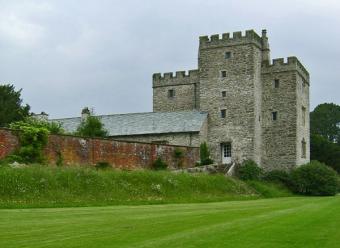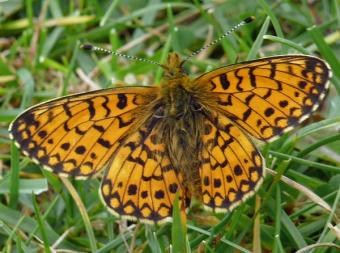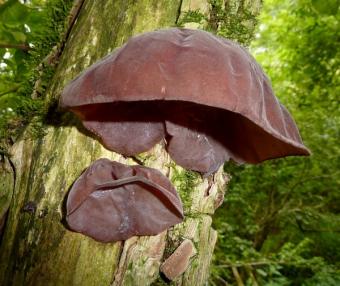 CastleThere were eighteen of us for today's trip. We divided into three groups, one chose to complete a tour of the garden and/or house and/or meadow: another did the Northern loop walk in search of butterfly orchid: the third climbed Scout Scar from Heslington church for views and butterflies. There was a spot of rain but in the main we kept dry. We were united for a drink at the excellent National Trust visitor centre at the end of the walk.
There was a lot to delight the six of us in the gardens group. We saw numerous scarecrows dotted around the garden in amusing poses. The main garden had been built on limestone rock and contains interesting ferns such as Royal fern also skunk cabbage, primulas, acers and water lilies. There was a vegetable/herb garden and an orchard with a border of interesting ornamental ferns. The extensive lake and hay meadows complemented the grey stone of the house. Janet proved to be our knowledgeable garden guide.
It was my plan to visit the meadow on the South loop walk. I found it was covered with an assemblage of traditional hay meadow plants; salad burnet, birdsfoot trefoil, fairy flax, speedwell and thyme but my search for orchid species was in vain. I saw two common blue butterflies dancing together. I took an alternative path back to the castle which soon petered out however I walked carefully around the edge of the hay field and climbed a wall and a gate which led me to the homeward path. Farmers were busy in the fields cutting the hay and feeding the sheep. A buzzard was seen in the distance and swallows circled overhead. The mist prohibited really good views of the Lakes and Morecambe Bay. It was great to be in such a lovely part of Northern England.
CastleThere were eighteen of us for today's trip. We divided into three groups, one chose to complete a tour of the garden and/or house and/or meadow: another did the Northern loop walk in search of butterfly orchid: the third climbed Scout Scar from Heslington church for views and butterflies. There was a spot of rain but in the main we kept dry. We were united for a drink at the excellent National Trust visitor centre at the end of the walk.
There was a lot to delight the six of us in the gardens group. We saw numerous scarecrows dotted around the garden in amusing poses. The main garden had been built on limestone rock and contains interesting ferns such as Royal fern also skunk cabbage, primulas, acers and water lilies. There was a vegetable/herb garden and an orchard with a border of interesting ornamental ferns. The extensive lake and hay meadows complemented the grey stone of the house. Janet proved to be our knowledgeable garden guide.
It was my plan to visit the meadow on the South loop walk. I found it was covered with an assemblage of traditional hay meadow plants; salad burnet, birdsfoot trefoil, fairy flax, speedwell and thyme but my search for orchid species was in vain. I saw two common blue butterflies dancing together. I took an alternative path back to the castle which soon petered out however I walked carefully around the edge of the hay field and climbed a wall and a gate which led me to the homeward path. Farmers were busy in the fields cutting the hay and feeding the sheep. A buzzard was seen in the distance and swallows circled overhead. The mist prohibited really good views of the Lakes and Morecambe Bay. It was great to be in such a lovely part of Northern England. Margaret
 Small Pearl Bordered FritillaryFive opted for the walk to Scout Scar. We parked at Heslington church and walked down into the Lyth valley, once renowned for damsons but now seemingly almost bereft of them, before we made the short but steep ascent of Scout Scar. The overcast grey weather made any long-distance views non-existant and seemed to discourage many of the birds too, although we did see and hear stonechat and saw a buzzard but only recorded 22 species all day. Botanical highlights were dropwort, greater butterfly orchid and the usual delights of Scout Scar – lovely limestone plants and the Scout Scar specialities: heather on limestone, juniper and Lancastrian whitebeam. The grey weather did not encourage many butterflies onto the wing, but in the brighter intervals we did manage to find dark green and small pearl-bordered fritillaries as well as small tortoiseshell. A very pleasant walk thanks to Donald’s leadership.
Small Pearl Bordered FritillaryFive opted for the walk to Scout Scar. We parked at Heslington church and walked down into the Lyth valley, once renowned for damsons but now seemingly almost bereft of them, before we made the short but steep ascent of Scout Scar. The overcast grey weather made any long-distance views non-existant and seemed to discourage many of the birds too, although we did see and hear stonechat and saw a buzzard but only recorded 22 species all day. Botanical highlights were dropwort, greater butterfly orchid and the usual delights of Scout Scar – lovely limestone plants and the Scout Scar specialities: heather on limestone, juniper and Lancastrian whitebeam. The grey weather did not encourage many butterflies onto the wing, but in the brighter intervals we did manage to find dark green and small pearl-bordered fritillaries as well as small tortoiseshell. A very pleasant walk thanks to Donald’s leadership.
Stuart

John
